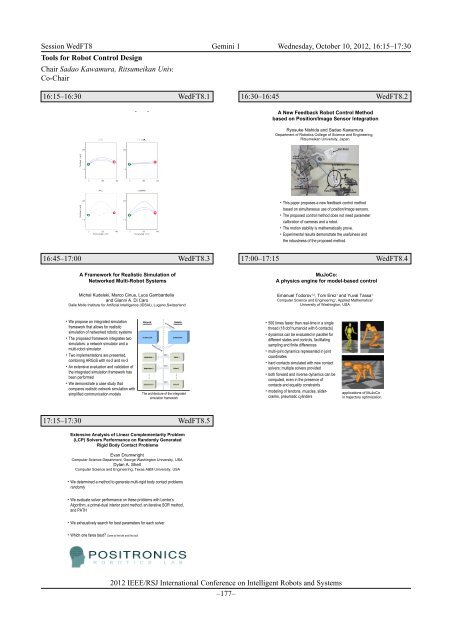Session WedAT1 Pegaso A Wednesday, October 10, 2012 ... - Lirmm
Session WedAT1 Pegaso A Wednesday, October 10, 2012 ... - Lirmm
Session WedAT1 Pegaso A Wednesday, October 10, 2012 ... - Lirmm
- TAGS
- pegaso
- october
- lirmm
- www2.lirmm.fr
You also want an ePaper? Increase the reach of your titles
YUMPU automatically turns print PDFs into web optimized ePapers that Google loves.
<strong>Session</strong> WedFT8 Gemini 1 <strong>Wednesday</strong>, <strong>October</strong> <strong>10</strong>, <strong>2012</strong>, 16:15–17:30<br />
Tools for Robot Control Design<br />
Chair Sadao Kawamura, Ritsumeikan Univ.<br />
Co-Chair<br />
16:15–16:30 WedFT8.1<br />
Minimum Angular Acceleration Control for<br />
Atrticulated Body Dynamics<br />
16:45–17:00 WedFT8.3<br />
A Framework for Realistic Simulation of<br />
Networked Multi-Robot Systems<br />
Michal Kudelski, Marco Cinus, Luca Gambardella<br />
and Gianni A. Di Caro<br />
Dalle Molle Institute for Artificial Intelligence (IDSIA), Lugano,Switzerland<br />
• We propose an integrated simulation<br />
framework that allows for realistic<br />
simulation of networked robotic systems<br />
• The proposed framework integrates two<br />
simulators: a network simulator and a<br />
multi-robot simulator<br />
• Two implementations are presented,<br />
combining ARGoS with ns-2 and ns-3<br />
• An extensive evaluation and validation of<br />
the integrated simulation framework has<br />
been performed<br />
• We demonstrate a case study that<br />
compares realistic network simulation with<br />
simplified communication models<br />
The architecture of the integrated<br />
simulation framework<br />
17:15–17:30 WedFT8.5<br />
Extensive Analysis of Linear Complementarity Problem<br />
(LCP) Solvers Performance on Randomly Generated<br />
Rigid Body Contact Problems<br />
Evan Drumwright<br />
Computer Science Department, George Washington University, USA<br />
Dylan A. Shell<br />
Computer Science and Engineering, Texas A&M University, USA<br />
• We determined a method to generate multi-rigid body contact problems<br />
randomly<br />
• We evaluate solver performance on these problems with Lemke’s<br />
Algorithm, a primal-dual interior point method, an iterative SOR method,<br />
and PATH<br />
• We exhaustively search for best parameters for each solver<br />
• Which one fares best? Come to the talk and find out!<br />
16:30–16:45 WedFT8.2<br />
A New Feedback Robot Control Method<br />
based on Position/Image Sensor Integration<br />
Ryosuke Nishida and Sadao Kawamura<br />
Department of Robotics College of Science and Engineering,<br />
Ritsumeikan University, Japan<br />
• This paper proposes a new feedback control method<br />
based on simultaneous use of position/image sensors.<br />
• The proposed control method does not need parameter<br />
calibration of cameras and a robot.<br />
• The motion stability is mathematically prove.<br />
• Experimental results demonstrate the usefulness and<br />
the robustness of the proposed method.<br />
17:00–17:15 WedFT8.4<br />
MuJoCo:<br />
A physics engine for model-based control<br />
Emanuel Todorov 1,2 , Tom Erez 1 and Yuval Tassa 1<br />
Computer Science and Engineering 1 , Applied Mathematics 2<br />
University of Washington, USA<br />
• 500 times faster than real-time in a single<br />
thread (18 dof humanoid with 6 contacts)<br />
• dynamics can be evaluated in parallel for<br />
different states and controls, facilitating<br />
sampling and finite differences<br />
• multi-joint dynamics represented in joint<br />
coordinates<br />
• hard contacts simulated with new contact<br />
solvers; multiple solvers provided<br />
• both forward and inverse dynamics can be<br />
computed, even in the presence of<br />
contacts and equality constraints<br />
• modeling of tendons, muscles, slidercranks,<br />
pneumatic cylinders<br />
<strong>2012</strong> IEEE/RSJ International Conference on Intelligent Robots and Systems<br />
–177–<br />
applications of MuJoCo<br />
in trajectory optimization

















